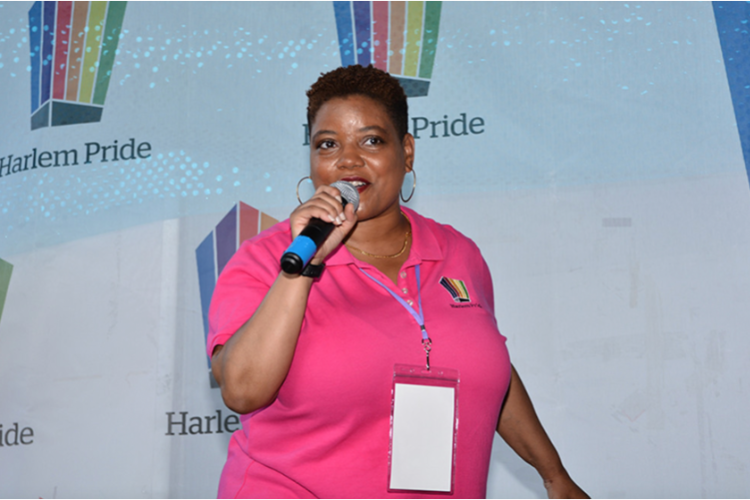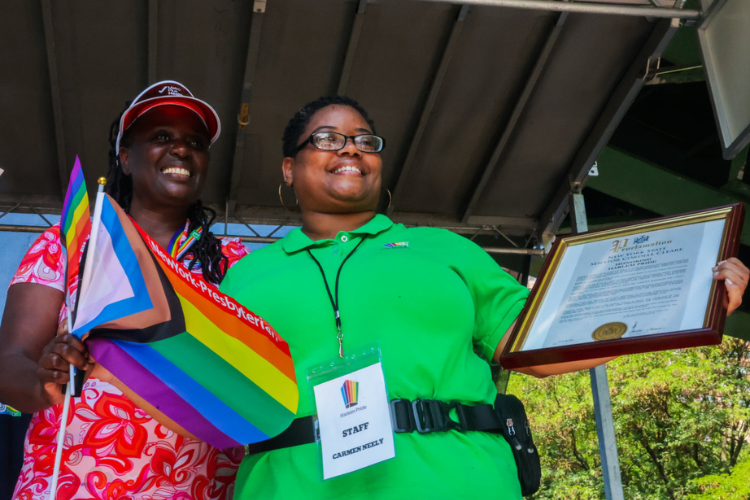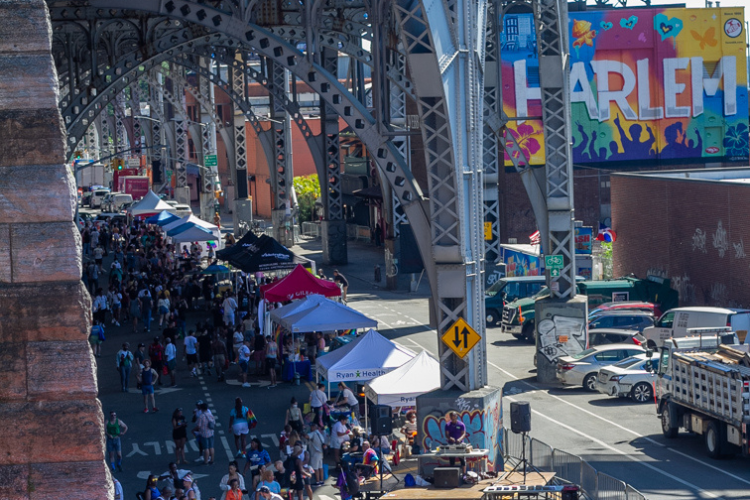'Harlem Pride Is Leading a New Renaissance': A Conversation with Co-Founder Carmen Neely
We spoke with Neely about the vision behind Harlem Pride and their annual celebration which makes its grand return on June 24.

The Harlem Renaissance is a widely-known chapter of Uptown history, however, an often overlooked yet crucial element of this period are the contributions of LGBTQ luminaries who were at the forefront of social, cultural, and political change. Standing on their shoulders is social impact leader Carmen Neely, who co-founded the nonprofit Harlem Pride alongside Lawrence Rodriguez.
What started as a Pride Month-inspired block party on 119th and Lenox Avenue nearly 15 years ago has emerged into an Uptown movement. The organization works to provide same gender loving and LGBTQ communities in Harlem with resources and support for physical, mental, and economic wellness. The nonprofit's annual Harlem Pride event has become a staple in Upper Manhattan; uniting thousands under the iconic arches on 12th Avenue for a celebration of love, authenticity, equality, and inclusivity.
Columbia Neighbors spoke with Neely about the evolution of Harlem Pride, how the nonprofit is filling gaps in the neighborhood through its community-driven initiatives, and the inspiration behind this year's "Fearlessly Forward" theme.
What is the origin story behind Harlem Pride?
I was leading another nonprofit called Crucial Arts Productions and we were doing documentary films that centered on African American experiences. We were in search of a venue, and I connected with the co-founder of Harlem Pride, Lawrence Rodriguez, who at the time had his own art space called Casa Frela Gallery within his Harlem brownstone. As we moved Crucial Arts to his space, Lawrence and I quickly realized that we were both queer. From there, we connected and started supporting each other’s organizations.
I created a Harlem Pride logo that was inspired by the Adam Clayton Powell Jr. State Office Building, which at the time was the tallest building in Harlem, and put it on a t-shirt. I started wearing the shirt to a lesbian poetry night at Billie's Black and people began to inquire about whether there would be a Pride celebration in Harlem.
After Lawrence and I realized there weren’t any Pride events Uptown, we decided to organize a block party. Lawrence’s partner was a member of the Block Association on West 119th Street, and they had a permit for a party during the last full weekend of June. They allowed us to join their permit. We ended up having 20 vendors, live entertainment organized by Rob De Anthony of Our Youth, and elected officials speak, including the late Bill Perkins. At one point I saw some elder women crying and I thought something was wrong, it turns out they were tearing up because they never thought they’d see a celebration like this in Harlem. We didn’t expect a huge turnout, but nearly 2,500 people showed up and we decided we have to continue this.
Can you talk about the mission and vision behind Harlem Pride and how its evolved since its inception?
Our mission has evolved over time. Our initial mission was about visibility and creating a sense of unity and community. When we did our 10-year organizational review, we felt like we had accomplished that. The next step was to try to ensure our community’s well-being is taken care of. Our current mission is to empower Harlem’s same gender loving, LGBTQ communities—which includes family, friends, and allies—to improve its physical, mental, and economic health and wellness.
How are Harlem Pride's community-driven initiatives filling gaps within the neighborhood?
We considered ourselves to be a Pride organization, but we realized there were some things that needed to be addressed. We realized our community needed more programs and services. We started having a community forum series in 2012 where we would team up with local groups and invite them to talk about medical proxies and how to handle wills. This was before marriage equality. As our organization grew, we began to invite city agencies, like NYC Health + Hospitals, Harlem United, Black Health, and other nonprofits that would provide critical health services including insurance navigation, HIV testing, COVID testing, and now Mpox testing.
From an economic wellness standpoint, we’ve worked with organizations like the Harlem Business Alliance and the National Gay & Lesbian Chamber of Commerce. We also organized a free eight-week entrepreneurship program that helped individuals take their business ideas to the creation stage. Our idea is that instead of being at the behest of would-be employers who may or may not like the way we identify or the way we present, we wanted to focus on honing our talents and turning them into a viable business so that we are the business owners, the employers, and we can give back to our own communities by employing others like us. Our economic wellness initiatives also center on financial literacy.
One of the most overlooked elements of the Harlem Renaissance is the cultural contributions of SGL/LGBTQ icons, can you share your thoughts about the importance of spreading awareness about their contributions?
Most people don’t know that a majority of key figures who were part of the Harlem Renaissance were in some way, shape, form, or fashion members of the LGBTQ community. We like to bring light to it so people can recognize that when it comes to fighting the stigma of being part of the LGBTQ community. We want people to know that we can contribute to Harlem’s well-being just as much as the next person, regardless of our sexual orientation or gender identity. In the past, we’ve done perhaps more than any other groups, in certain ways, to contribute to Harlem’s illustrious history and legacy. Harlem Pride is leading a new renaissance by being loud, proud, and visible and the community at large is welcome to join us. I always felt safe to be who I am here in Harlem. We’re here, we want the best for Harlem as a community.
Harlem Pride is leading a new renaissance by being loud, proud, and visible.
What is your definition of allyship?
Allyship is taking action that benefits others outside of yourself. Speaking up for others, and being visible with speaking up for others, when it doesn’t necessarily benefit you—that’s an ally. If you hear someone misgendering a trans person as you’re walking by the street, turn around and address it. Don’t just keep walking by. Silence is nothing. We need to have people speak out on our behalf.
LGBTQ rights are still under attack, what can we do to change the narrative? From your perspective, what are some of the most challenging issues facing the community right now?
We have to vote. All of these legislative changes and new bills etc. are being created by people who are elected officials. We have to be even more serious about who we vote for and why and really take time to discern who we’re putting in power. What’s going to happen as a result of this person being in office? Outside of that, it’s also about protesting and bringing visibility to what these elected officials are doing so we know which individuals to vote out of office.
The most challenging issue right now is everything that is affecting our trans siblings. I can walk the street and people will see me as Black. People may know that I’m a lesbian. Some of our trans siblings don’t have that privilege and they need to be protected. They have rights just like anyone else. They’re people, just like anyone else. They need to have hormone therapy. They need to have the surgeries that they elect to have. They need to have access to adequate and culturally competent care. Collectively, we don’t want to be tolerated, we want to be respected. You don’t have to like us, just respect our right to exist.
What is your most memorable Harlem Pride celebration moment?
I have two. Last year when we presented a rendering of our proposed Harlem SGL•LGBTQ Center on stage with the developer and the mayor. The mayor pledged his support for our center along with almost every other elected official in Harlem. Seeing that support and comradery on stage from our elected officials was great.
A very close second would be the moment we realized we had outgrown Jackie Robinson Park. That was our home for many years.
Our very first year, we were on West 119th between Lenox and 5th Avenue and then we moved to Marcus Garvey Park. Then, from 2012 to 2016, we were in Jackie Robinson Park and we loved it. The shape of the park is more of a rectangle, so it had a real family reunion feel. As the turnout for our celebration continued to grow, we had to move to 12th Ave. It has been our new home and we love it. People come to get their services every year and to see people they haven’t seen since last year. We are definitely moving forward.

What is the inspiration behind this year's 'Fearlessly Forward' theme? What can attendees expect from this year's celebration?
Post-COVID, we didn’t know how things would be coming out of 2020. That year, we ended up having a virtual Pride. In 2021, we had a hybrid Pride. In 2022, we hosted it in person and we had approximately 21,000 people attend. This is another period of growth for us in terms of the event, and we’re going to keep moving fearlessly forward. We’re so excited about what we’re looking forward to because next year is our 15th anniversary. We are moving fearlessly forward into our future.
What inspires you?
It’s the community work. I feel like I’ve always been one who worked toward helping people and giving back. On a personal level, it’s to be able to provide today’s youth, seniors, and adults with what I didn’t have growing up. It’s also to help put in place what I hope to have as I continue to age. I’m inspired by today’s visibility with the youth because it wasn’t there when I was a young teenager trying to figure out these emotions and feelings that I had, not seeing any examples, and being afraid to speak to the adults in my life. We’re here to help them understand that life goes on and life can be good living it authentically. We’re here for our seniors as well; to help them navigate their golden years.

What's on the horizon for Harlem Pride?
Right now, we’re part of a group that is bringing a community center to Harlem. One tower has already been built and opened last October. The second tower is being built right now and will hold our 3,000-square-foot temporary space until we move into the third and last tower, which will provide us with 20,000 square feet of space permanently. We’re making inroads and we’re making it clear that the center is LGBTQ-focused, but will still harbor programs for the local community. Our center will be one-of-a-kind. We plan on offering various programs in collaboration with other LGBTQ groups. It will be a space where we invite all voices to the table. We’re organizing a Community Action Board, we will have a diverse board of directors and a staff that reflects the LGBTQ community. We’re also working on revamping and expanding our Legacy of Pride Awards celebration to deliver it on a grander scale.